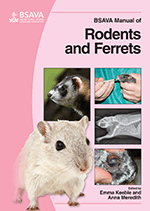
Full text loading...

Unfortunately, as rodents are prey species, clinical signs are often masked until the course of the disease is far advanced and the pet is presented on an emergency basis. The principles of emergency and critical care apply equally to rodents, but the anatomical, physiological and behavioural differences of these species require careful consideration when developing an initial plan of emergency therapy. Many rodents are highly predisposed to stress and so rapid evaluation and patient stabilization are often required before complete evaluation for a definitive diagnosis can be performed. This chapter explains Patient handling and restraint; History and physical examination; Clinical techniques; and Triage of the emergency rodent patient.
Rodents: physical examination and emergency care, Page 1 of 1
< Previous page | Next page > /docserver/preview/fulltext/10.22233/9781905319565/9781905319565.2-1.gif

Full text loading...


















